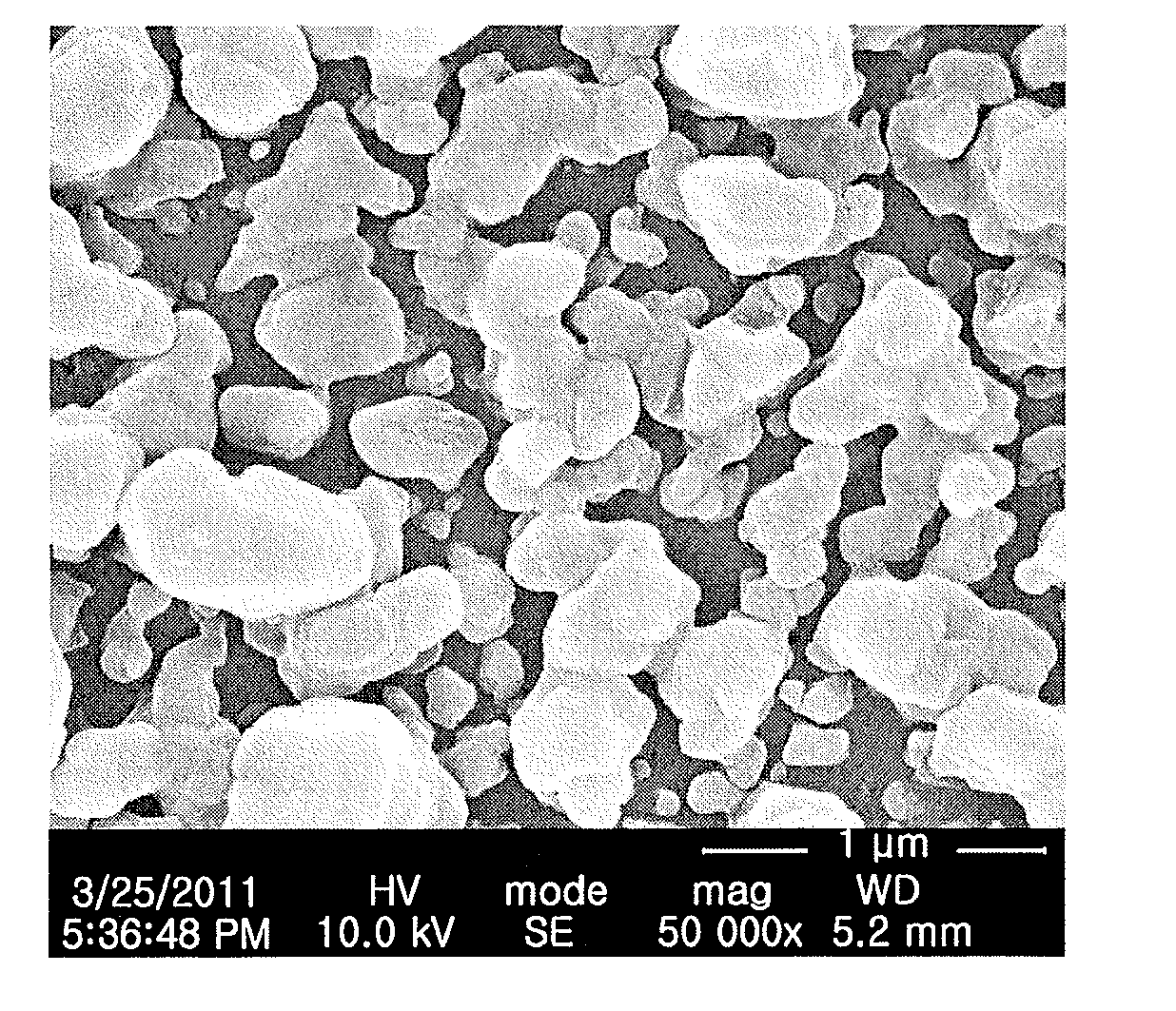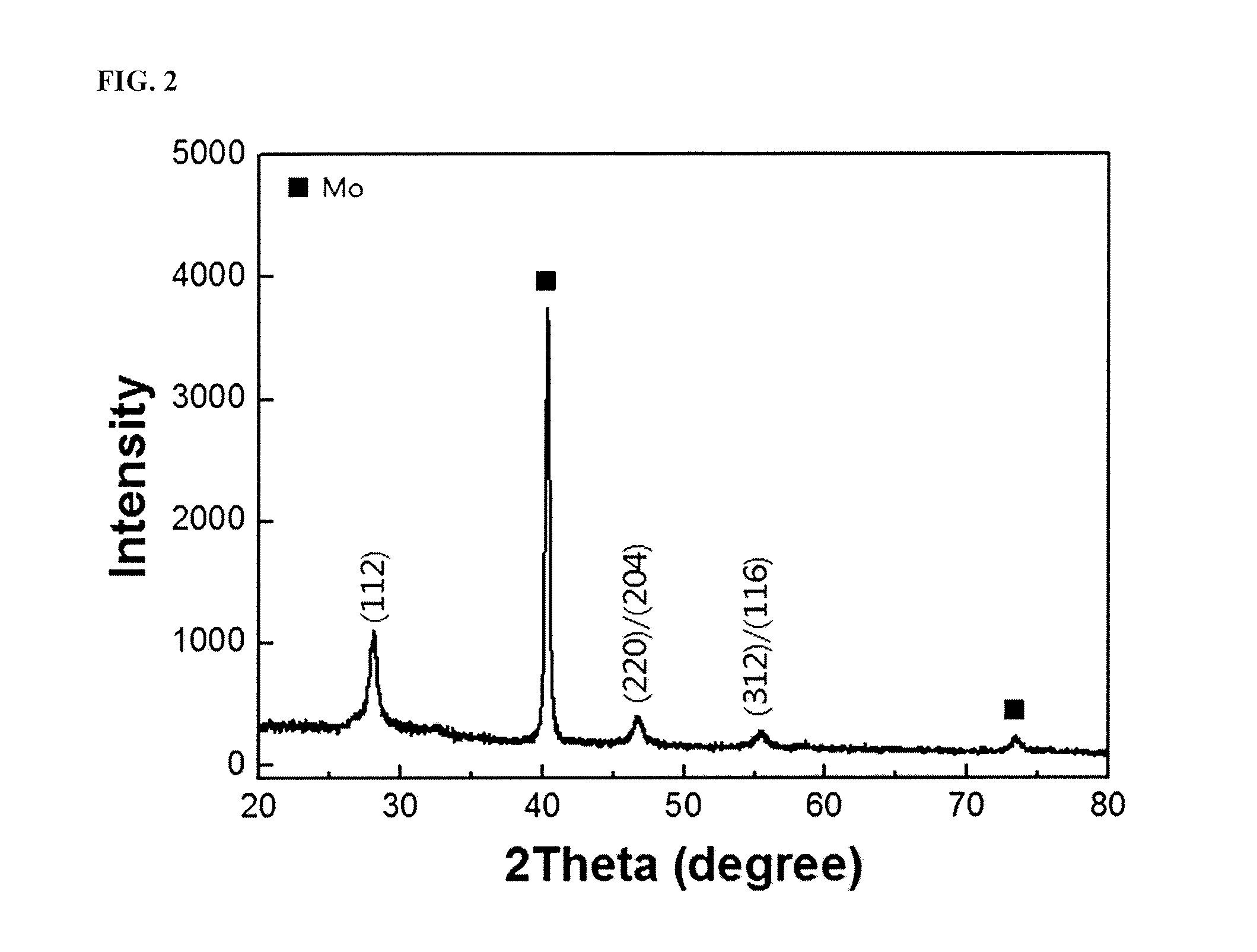Methods for producing chalcopyrite compound thin films for solar cells using multi-stage paste coating
a technology of solar cells and chalcopyrite, which is applied in the direction of sulfur compounds, chemistry apparatus and processes, solid-state devices, etc., can solve the problems of high manufacturing cost, high cost of silicon solar cells, and need expensive vacuum systems, so as to improve coating rate and reduce consumption of metal raw materials , the effect of low cos
- Summary
- Abstract
- Description
- Claims
- Application Information
AI Technical Summary
Benefits of technology
Problems solved by technology
Method used
Image
Examples
example 1
Production of CIGS Thin Film Using Multi-Stage Coating of Two Kinds of Pastes Having Different Viscosities
[0075]1 g (5 mmol) of Cu(NO3)2.xH2O, 0.4 g (1.6 mmol) of Ga(NO3)3.xH2O and 1.12 g (3.7 mmol) of In(NO3)3.xH2O were dissolved in 80 mL of ethanol. The solution was mixed with 20 mL of a solution of 13.7 g of terpineol and 0.75 g of ethyl cellulose in ethanol with stirring. Thereafter, the ethanol was removed by evaporation at 40° C. for 1 hr to obtain a CIG precursor paste having a sufficiently high viscosity. The paste was spin coated on a Mo glass substrate and dried on a hot plate at 150° C. for 3 min. As a result of the drying, the paste was solidified.
[0076]1 g (5 mmol) of Cu(NO3)2.xH2O, 0.4 g (1.6 mmol) of Ga(NO3)3.H2O, and 1.12 g (3.7 mmol) of In(NO3)3.xH2O were dissolved in 7 mL of methanol. The solution was mixed with 1 g of polyvinyl acetate and 7 mL of methanol with stirring to prepare a CIG precursor paste having a different viscosity from the previous CIG precursor p...
example 2
Production of CIGS Thin Film by Coating of Two Kinds of Pastes Having Different Compositions of Elements
[0083]1 g (5 mmol) of Cu(NO3)2.xH2O and 1.36 g (5 mmol) of Ga(NO3)3.xH2O were dissolved in 7 mL of methanol. The solution was mixed with 1 g of polyvinyl acetate and 7 mL of methanol to obtain a paste of the Cu and Ga precursors. The paste was spin coated on a glass substrate and thermally treated on a hot plate at 150° C. for 3 min and at 300° C. for 7 min. As a result of the thermal treatment, the paste was solidified.
[0084]1 g (5 mmol) of Cu(NO3)2.H2O and 1.6 g (5 mmol) of In(NO3)3.xH2O were dissolved in 7 mL of methanol. The solution was mixed with 1 g of polyvinyl acetate and 7 mL of methanol with stirring to obtain a paste of the Cu and In precursors. The two pastes had different compositions of the elements. The paste was spin coated on the thin film of the previous CIG precursor paste, followed by sequential thermal treatment on a hot plate at 150° C. for 3 min and at 300°...
example 3
Fabrication of Solar Cell Using CIGS Thin Film Produced by Multi-Stage Paste Coating
[0089]The CIGS thin film produced in Example 1 was used as a light-absorbing layer to fabricate a CIGS thin film solar cell having a general structure known in the art. The other layers of the CIGS thin film solar cell were produced by methods well known in the art. That is, the CdS buffer layer was produced by chemical bath deposition and the ZnO or ZnO:Al window layer was produced by sputtering.
[0090]Finally, Al was deposited to form an electrode, completing fabrication of the device. The J-V characteristics of the device were measured. The device was found to have a photoelectric conversion efficiency of 4.57%. The results are shown in FIG. 8.
PUM
| Property | Measurement | Unit |
|---|---|---|
| viscosity | aaaaa | aaaaa |
| viscosities | aaaaa | aaaaa |
| viscosities | aaaaa | aaaaa |
Abstract
Description
Claims
Application Information
 Login to View More
Login to View More - R&D
- Intellectual Property
- Life Sciences
- Materials
- Tech Scout
- Unparalleled Data Quality
- Higher Quality Content
- 60% Fewer Hallucinations
Browse by: Latest US Patents, China's latest patents, Technical Efficacy Thesaurus, Application Domain, Technology Topic, Popular Technical Reports.
© 2025 PatSnap. All rights reserved.Legal|Privacy policy|Modern Slavery Act Transparency Statement|Sitemap|About US| Contact US: help@patsnap.com



